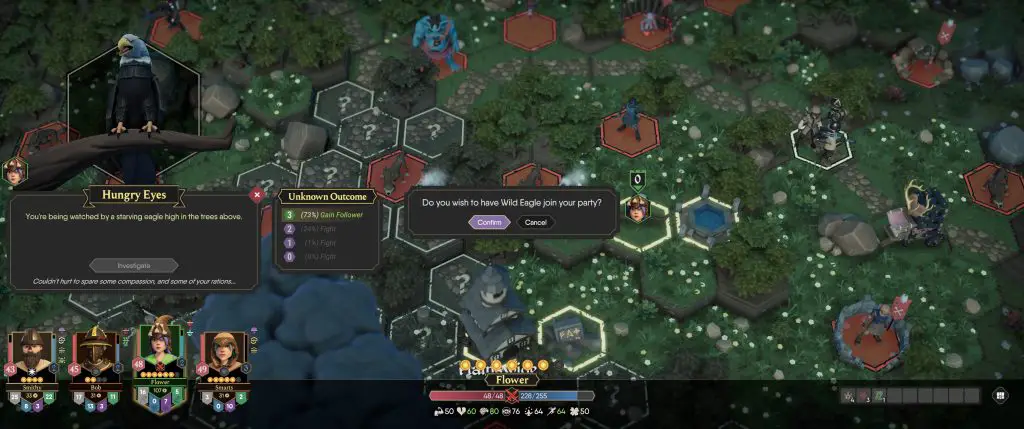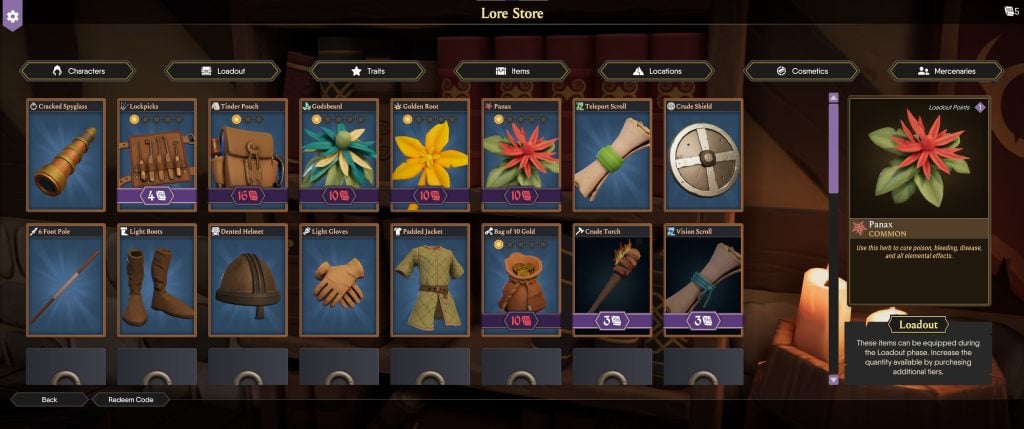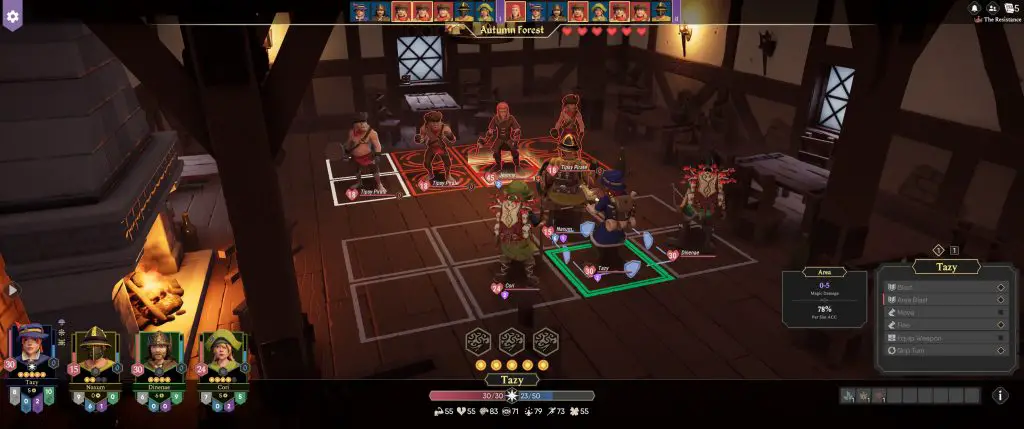The sequel to the highly rated turn-based RPG For the King is out. Does this new tabletop-style game stand up to the first one from 5 years ago? Does it enhance the experience, stand out as its own turn-based RPG, or fall flat on its face like your party after being walloped by a troll? Let’s jump in and find out.
In this For the King 2 Review, I’m going to discuss:
Story
For the King 2 continues the story where the first one left off. The once peaceful Queen Rosomon who ruled the prospering land for many years has now turned against her subjects. She cast the kingdom, Fahrul, into darkness as she built alliances with sinister forces. But resistance is building. Adventurers from all across the land gather to prevail against the now-evil queen.
Gameplay
Similar to the first game, For the King 2’s main gameplay loop is exploring the map to finish quests and battle enemies. You are free to explore the fog of war as much as you want, but things get progressively harder each turn as you race the timer. If you take too long, then the chaos events can have some pretty negative effects. Let’s get into the different parts of the gameplay.
Game Setup
The story of For the King 2 has been broken up into 5 chapters. This makes it easier to start at the beginning of the chapter after a bad run, rather than starting from the very beginning. It is a turn-based roguelite, so expect to start over at least a few times. Depending on your difficulty settings of course.

After selecting the chapter that you would like to play, a difficulty menu will appear. There are 3 default options labeled as Apprentice, Journeyman, and Master. These adjust the varying settings in the game such as Life Pool, Loadout Points, Chaos Speed, and Market Inflation. You are also free to customize the individual settings as you see fit. So feel free to bump that life pool all the way up to 10 if you think the 6 on the Apprentice setting isn’t going to be enough.
Characters
Next up is the party selection screen. In For the King 2 you are able to take a party of 4 characters on your quest. There are 5 unlocked character classes at the start of the game, with several more to be found throughout Fahrul during your adventures. The starting classes include Hunter, Blacksmith, Stablehand, Scholar, and Herbalist. Each class has different starting stats as well as special abilities. So make sure you browse through each one to find what matches your play style the best.
Customization
From this menu, you also have the opportunity to customize the look of your characters. These customization options include name, gender, starting gear color, and looks (more can be unlocked later), as well as hair and skin color. The options are pretty basic, but you will quickly be swapping out your starting gear for much better stuff anyway. It usually looks better too.
Loadout
There is just one more step after settling on the look of your party. This is where the Loadout Points come in that were set when you selected a difficulty. Each member of the party gets the same amount of Loadout Points. However, only one of each item can be selected for the entire party. So, make your allocations wisely.
Now, each character has a set of starting equipment depending on their class. So, the Loadout Points are for additional things that might be helpful at the start of your adventure, such as a shield for the Stablehand or healing herbs for the Herbalist. Even more things like Traits can be selected in the loadout menu once they are unlocked in the Lore Store. Something we will talk about more later.
Overworld
The majority of your adventure is going to be spent in the overworld view or in combat. Let’s start with the overworld view first. In this view, you will be able to see all the different towns, dungeons, events, and enemies throughout Fahrul. This is also where you can view the timeline. The timeline shows you what round you are in and when the next chaos event will occur. Both are important things to keep an eye on.

Towns
The towns scattered around Fahrul provide some sanctuary from combat with services to heal your characters, replenish focus, or even remove curses. Towns also offer a market for selling and buying goods or gear for your party. There are quest boards that can offer side quests with grand rewards. If you can finish them in time.
Only one quest can be selected per town though, so make sure you are ready to complete the task before selecting it. Lastly, there is a Merc Guild which allows you to hire a mercenary to join your party for a set number of rounds.
Events
Another thing that is scattered around the world with high frequency is events. There are all sorts of interactable events that you can come across. Some might be Stone Heroes that restore a character’s focus or Sanctums that can prevent your hero from dying.
Some events require a specific stat to be tested. Failing the event could result in a loss of XP or health, but a successful event can result in high-valued loot or even a special companion for that character. Visiting these events can be very beneficial to your adventure. Just ensure you select the best hero for the task when you can.

Movement
Moving around the overworld is one of the things that makes For the King 2, and its predecessor, unique from other games. For the King 2 can be thought of as a party-based game, but all the characters are individuals. What do I mean by that? Well, let’s discuss moving around Fahrul.
Unlike other games in the genre, each character has their own movement turn. At the beginning of each character’s turn, dice are rolled to see how far they can move. Varying things can affect the movement roll, such as stats, gear, or even the weather. Then the character is free to move around the map that distance. What makes this unique is that your party doesn’t move as one unit.
This comes into effect, especially when engaging enemies. If the other members of your party are not close enough to the enemy, then they will not be pulled into that combat. So the player has the freedom to split the party up to really explore the map. As a result, they risk dangerous counters where one hero might not be strong enough to deal with the challenge on their own. This creates a very different style of gameplay than what is in most RPG-style games.
Combat
While you are exploring the overworld, there are going to be a lot of enemies that appear around the map. So, it is usually beneficial to keep your party close together. Then, they will all be pulled into combat together. So let’s talk a little bit about what the combat looks like in For the King 2.

Battle Grid
The combat view is broken up into separate 2×4 grids. One for the heroes and one for the enemies. With the exception of some larger enemies, most characters only take up one square on the grid. This means you can encounter quite a few enemies in a single combat.
The back row is primarily for ranged characters such as archers and mages. It also provides an evasion boost. Characters must be in the back row if they are trying to flee combat. The front row is for the melee-focused characters. Those with a shield in the font can also provide protection to allies directly behind them.
Each combat encounter has your heroes randomly positioned on the grid. Granted melee in the front and ranged in the back. But you might still have to do some moving around if you want a certain character protected by the shield of another. You might also want to consider positioning depending on the opponent you are facing. A lot of enemies tend to have attacks that can hit multiple targets. This means grouping your whole party up into a 2×2 square might not always be the best option.
Attacking
Most heroes, on their turn, will have 1 primary and 1 secondary action. The primary action is used for actions that would end your turn. Such as attacks, fleeing, or skipping that character’s turn. Secondary actions are used for moving to an adjacent square, using items, or swapping weapons.
When picking an attack, some stats will pop up showing the damage range, hit percentage, and any ability it might have, such as stun on a successful hit. One way to increase the hit percentage is by using your character’s focus. This resource in For the King 2 has a few different uses, but I tend to find it most helpful in guaranteeing my hits in combat, especially against some of those really tough foes.

Loot
At the end of a successful combat encounter, a menu will appear with your loot. For the gold, each character has the opportunity to take it for themselves or share it with the party. For gear, each party member has the option to take or equip the item. Hovering over the equip option does show what the hero currently has equipped. This is a nice feature to be able to compare gear at the end of combat quickly.
Life Pool
If one of your characters falls in combat, you can have an ally revive them at the cost of a heart from the Life Pool. This can be done either in combat or in the overworld view. Each adventure has a set number of revives based on your selected difficulty. There are a few events that allow you to gain revives back into the Life Pool, but they aren’t very common.
Lore Store
During your adventures in Fahrul, certain quests will provide you with an in-game currency known as Lore. You can spend this currency to unlock special weapons, character classes, and even cosmetics. These unlocked items will be reflected in future adventures to help in your victory against the tyrant queen. This is a main element in For the King 2 that plays towards the roguelite experience—allowing you to improve your party a little bit more each time for a more successful run.

Multiplayer
As a fan of the turn-based genre, I tend to play a lot of single-player games. Partly because I enjoy single-player mode, but largely because there are not a lot of co-op multiplayer games in the genre. One of For the King 2’s big selling points is its multiplayer co-op.
Setup
Multiplayer in For the King 2 is very quick to set up and simple to secure. If you don’t want any strangers joining your game, you can just add a password. Then you send the game code to your friends and you are good to go.
Once everyone is in, everything looks the same as the single-player setup. You have the same customization when selecting your character class. Including the added benefit of getting anything that the other players might already have unlocked. The Loadout screen is the same. There is still a limit to one item per party. You can either discuss who gets what or make it a free-for-all I guess.
Once the adventure begins, the overworld view and combat look the same as in single-player, regardless of whose turn it is. The only difference is that you can only control your character on your turn. At the end of combat, you will get a turn to take or pass each item, if the person before you doesn’t take it first.
Better Together
So, I am sure you are thinking that it sounds pretty much the same as the single-player experience but with fewer heroes that you get to control. So is it worth getting a couple of copies and playing with friends instead of by yourself? I sure think so.
Multiplayer isn’t perfect. There are features that could be added to enhance the experience. Like seeing the other player’s cursor or where they click to suggest a location on the map or a certain attack in combat. Even without those features, I still prefer to play with someone rather than by myself. And the main reason for that is because it gives me more of that tabletop RPG feel.

I grew up sitting around a table with friends playing Dungeons and Dragons. As I get older, it gets harder and harder to get a group together with a Dungeon Master. Multiplayer in For the King 2 brings me back to that experience. I can play with a couple of people for a few hours when we are all free without worrying about who is playing and if we have a DM to lead the game. It’s that same tabletop experience of sitting around to have a laugh and good times with friends that I had growing up.
Critiques
As fun as For the King 2 is, it is not without its flaws. I already mentioned that there could be some updates to the interaction between players in multiplayer mode. The biggest issue that I ran into, though, was the tooltips. Rather the randomness of them. Some things like player stats and passive abilities had tooltips when hovered over. But things like Life Pool and Chaos Speed in the difficulty settings have no tooltip. How are new players supposed to know what those are?
There are quite a few icons in the game that seem to not have tooltips or a description. Specifically icons on weapons and gear. Most of the weapons have icons in the top left corner and in the middle of their item description box. A lot of those icons are not explained. Now there is a nice encyclopedia hidden away in the setting menu. However, I don’t want to pull that up every time I try to learn a new symbol. To me, that isn’t very helpful to players.
Along those same lines, are the dice rolls, in and out of combat. In combat, your character has a set number of dice they roll for their weapon. The successful rolls don’t seem to line up with the damage that your weapon is rated for. 3 dice for a weapon with a damage range of 0-9 should mean 3 damage per die, but sometimes you do 5 damage on 2 successful dice. I don‘t get it, and I didn’t see the logic explained in the encyclopedia either.
In the overworld view, sometimes your character randomly gets a sunny day bonus to their dice roll. Great! I sure won’t complain about extra movement, but why does only half the party get it? It only happens on some days, but I get bad rolls on movement for everyone on every rainy day. The inconsistency can be a little unnerving. It at least needs to be explained somewhere in the encyclopedia for those players who like to understand everything that is going on.

Conclusion
However, the important question is whether these inconsistencies make the game unplayable. I don’t think so. For me, it was annoying, but some players might be okay with the random chances in the game. Hopefully, they will at least update the encyclopedia for those of us who want more of the mechanics explained.
Overall, the game was fun, but as a single-player experience, I probably would not return to it. There wasn’t a whole lot of story, and the gameplay was ok. It was like trying to play Dungeons and Dragons by yourself when it is clearly meant for a group. Other than trying to get more lore to unlock stuff in the Lore Store, there wasn’t much to keep me coming back.
As a multiplayer experience, though. That is a different story. If one of my friends asked me to join their next session, I would jump in. For the King 2 was clearly built around that multiplayer tabletop experience. The game is really elevated once you have someone to play with. The lackluster parts of the game didn’t really matter because I was busy having fun with friends rather than focusing solely on the mechanics themselves. So, if you have a couple of friends that you like to play games with, I think For the King 2 is worth checking out.







